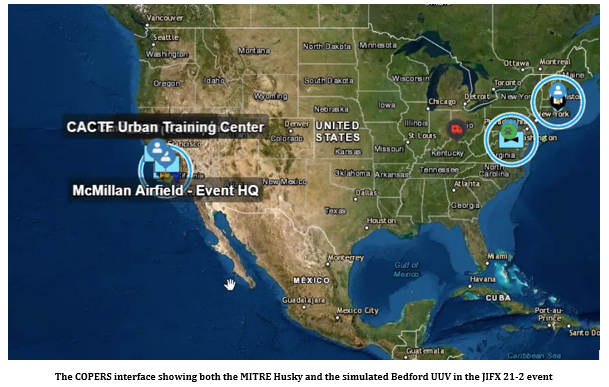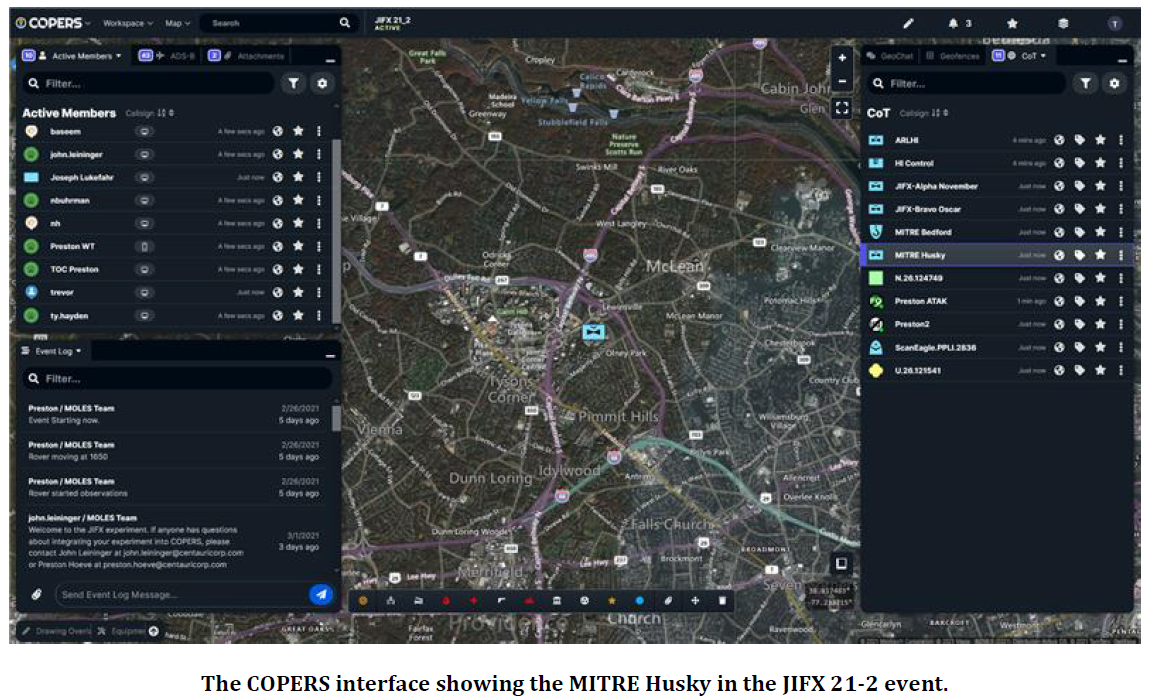
News
Distributed Collaboration for Innovating Autonomous Naval Systems
MITRE’s Naval Division and Naval Post Graduate School (NPS): Developing a Cross-Country, Multi-Institutional Demonstration and Experimentation Capability for Unmanned and Autonomous Systems
By: Ryan Fitzgerald, Dr. Carrie Rebhuhn, Tyler Fenton, Trevor Bostic, and Nick Rotker
MITRE is forging a new and exciting partnership with the Naval Post Graduate School, leveraging its Labs test infrastructure and NPS’s Sea, Land, Air Military Research Initiative (SLAMR) and Joint Interagency Field Experimentation (JFIX) program. Using an existing cooperative research and development agreement (CRADA), MITRE and Naval Post Graduate School (NPS) are working towards development of a cross-country and multi-organizational live, virtual, constructive (LVC) demonstration, experimentation, and eventual test and evaluation capability. The objective is to one day have a variety of manned, unmanned, and autonomous platforms at various facilities, including NPS’s SLAMR; MITRE’s McLean and Bedford labs; MITRE Bedford’s state of the art Advanced Maritime Systems Experimentation Lab (AMSEL); Camp Roberts Army National Guard Base (ANG); MITRE’s unmanned systems (UxS) experimentation area in Purcellville, VA; and others, combined with emulated or virtual platforms in a common environment which allows sharing of information and command and control across any and all users, at these facilities or any other location. There is also a plan to expand that partnership beyond NPS and to other organizations such as the University of Hawaii Advanced Research Lab (UHARL), a University Affiliated Research Center (UARC). The long-term plan for this effort is to enable distributed collaboration across the unmanned ecosystem that specifically includes industry partners, the start-up community, and academia to spur innovation and accelerate outcomes in this space.
MITRE and NPS took the first step in accomplishing this objective in March of this year by participating in the 21-2 JIFX. JIFX is held 4 times a year and run by NPS’s Director of Experimentation Dr. Ray Buettner. It occurs primarily at Camp Roberts ANG Base in Paso Robles and promotes collaborations and partnerships to improve warfighting technology. The field experimentation program allows NPS faculty, students, private companies, and academia to demonstrate and evaluate new technologies related to U.S. Navy and Department of Defense research in an operational field environment. With the challenges of COVID this past year, JIFX participants have expanded to remote locations, with MITRE’s participation in JIFX 21-2 at the MITRE Bedford and MITRE McLean serving as examples.
The MITRE Mobile Autonomous Systems Experimentation Lab’s Clearpath Husky unmanned ground vehicle platform, as well as a prototype unmanned undersea vessel (UUV) from the MITRE Undersea Signal Processing Lab, transported data to a common operating picture called Common Operating Picture for Event Response and Situational Awareness (COPERS) in support of JIFX 21-2.
The COPERS interface provides a method for individuals across multiple organizations to share data from live or simulated platforms. It builds upon the Cursor on Target capability that relies on XML messages to ship data to the web-hosted interface. The JIFX event provided an example of the diversity of platforms from which the COPERS system could share data. Not only were many different organizations represented at the event (which had many different underlying architectures), but a number of multi-domain systems, including ground, aerial, surface, and subsurface robotic vehicles, were featured, both simulated and live.

In a two-hour portion of the multi-day event, MITRE provided live GPS data from both main campuses: the Husky driving around the McLean campus, and a replay of acoustic and sensor data collected by a prototype in the large underwater acoustic tank, AMSEL. Representatives from Centauri LLC (the COPERS technical leads) zoomed into the represented platforms on the map and queried for more information.
Simultaneously, other institutions such as the NPS and the UHARL were providing simulated and live data from their robotic systems from SLAMR, in Monterey, California; Camp Roberts in Paso Robles, California; and UHARL in Honolulu, Hawaii, respectively. The below is a screen shot of the COPERS interface during JIFX 21-2.

While this was a successful first step, further work is required. During JIFX 21-2 MITRE discovered COPERS inability to ingest UUV acoustic sensor data natively; instead, it had to be converted to full motion video and sent to COPERS for use by the platform. This is only one among many data streams COPERS cannot currently ingest. Immediate next steps are to fully baseline COPERS capabilities and identify other forms and types of data relevant to shared situational awareness and command and control which it cannot natively ingest. MITRE and NPS plan to work together to identify development priorities for COPERS to further mature the capability. In addition, with identification of funding, MITRE plans to continue as a participant in future JIFX events, using them as milestones in development of the cross-country, multi-institutional LVC capability.
Both MITRE and NPS offer unique demonstration, experimentation, and simulation capabilities and facilities. NPS’s SLAMR facility is a multi-domain experimentation facility inclusive of several large UUV tanks, protected airspace for UAV flights, and is adjacent to the beach and ocean, providing a littoral environment.
MITRE’s AMSEL, currently in development, offers much of the same capability as NPS’s UUV tanks, but MITRE expands the UUV platforms that are available for test and experimentation. MITRE McLean and Bedford also have various labs and UxS platforms that can be connected into the shared environment. MITRE also has a sophisticated capability to perform simulated experiments (SIMEX) in their Simulation, Experimentation, and Analytics Lab (SEAL). Platforms which are hard to obtain, unavailable, or which would be too risky to include in physical experiments can be emulated by the SEAL. By integrating MITRE’s SEAL/SIMEX capability, labs, and test tank, with NPS’s SLAMR facility, and the Camp Roberts experimentation location, a plethora of environments and platforms (both real and virtual) can comprise meaningful demonstrations, experiments, and eventual test and evaluation. This combined capability will lower the barrier to entry for information and data sharing. In the future this will allow for sharing of robotics, unmanned, and autonomous systems testing and experimentation resources, capabilities, and ranges, and better collaboration with sponsors, industry and other FFRDC/UARC and academic partners.
With the formation of this strategic partnership, and the associated capability, MITRE is enabling development of not only the LVC capability, but other future collaborations in the unmanned and autonomous systems domain, ultimately furthering cooperation and partnership between industry, start-ups, academic institutions, and US government research to enable autonomy research for years to come.
For more information about MITRE’s partnership with NPS or about its participation in the 21-2 JIFX event, please contact Carrie Rebhuhn (crebhuhn@mitre.org), Tyler Fenton (tfenton@mitre.org), Trevor Bostic (tbostic@mitre.org), Ryan Fitzgerald (rfitzgerald@mitre.org), or Nick Rotker (nrotker@mitre.org).
Click for copy of Distributed Collaboration for Innovating Autonomous Naval Systems article
Approved for Public Release; Distribution Unlimited. Public Release Case Number 21-1509
©2021 The MITRE Corporation. ALL RIGHTS RESERVED.
